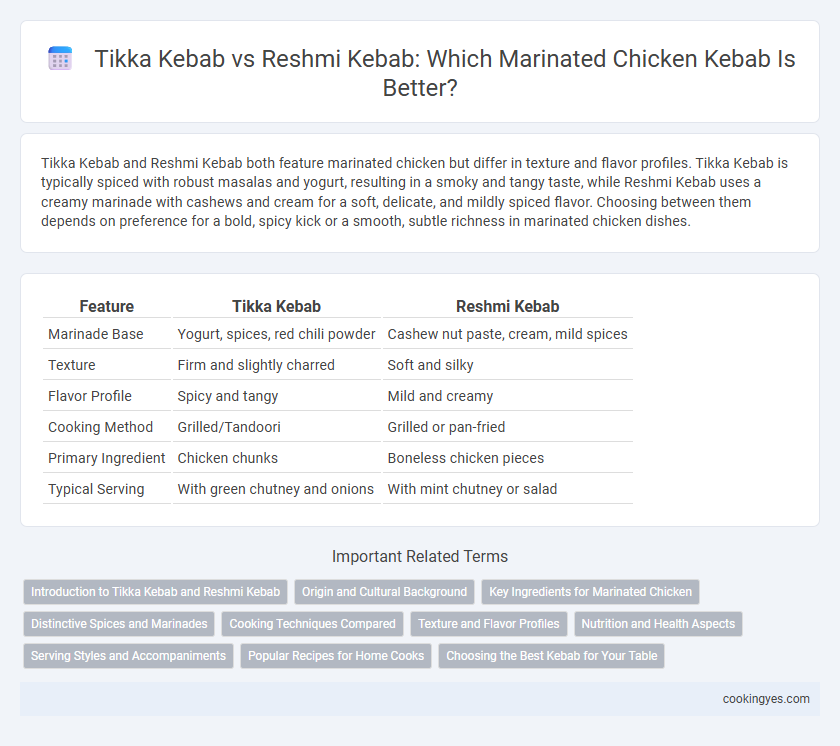Tikka Kebab and Reshmi Kebab both feature marinated chicken but differ in texture and flavor profiles. Tikka Kebab is typically spiced with robust masalas and yogurt, resulting in a smoky and tangy taste, while Reshmi Kebab uses a creamy marinade with cashews and cream for a soft, delicate, and mildly spiced flavor. Choosing between them depends on preference for a bold, spicy kick or a smooth, subtle richness in marinated chicken dishes.
Table of Comparison
| Feature | Tikka Kebab | Reshmi Kebab |
|---|---|---|
| Marinade Base | Yogurt, spices, red chili powder | Cashew nut paste, cream, mild spices |
| Texture | Firm and slightly charred | Soft and silky |
| Flavor Profile | Spicy and tangy | Mild and creamy |
| Cooking Method | Grilled/Tandoori | Grilled or pan-fried |
| Primary Ingredient | Chicken chunks | Boneless chicken pieces |
| Typical Serving | With green chutney and onions | With mint chutney or salad |
Introduction to Tikka Kebab and Reshmi Kebab
Tikka Kebab features marinated chicken pieces soaked in a robust mixture of yogurt, spices like cumin, coriander, and red chili powder, delivering a smoky and tangy flavor profile. Reshmi Kebab, on the other hand, consists of chicken marinated in a creamy blend of yogurt, cream, and ground cashews, lending it a rich, soft texture with subtle aromatic notes. Both kebabs showcase distinct regional spice blends that highlight diverse cooking traditions in Indian and Mughlai cuisine.
Origin and Cultural Background
Tikka Kebab, originating from the Indian subcontinent, is deeply rooted in Mughlai cuisine known for its robust spices and yogurt-based marinade, reflecting Persian culinary influences. Reshmi Kebab, hailing from North India, is characterized by its creamy texture and use of cashew nut paste and cream, showcasing a fusion of Mughal and Awadhi traditions. Both kebabs are integral to South Asian culinary heritage, representing distinct regional flavors and marination techniques that highlight their cultural uniqueness.
Key Ingredients for Marinated Chicken
Tikka Kebab features marinated chicken pieces soaked in a mixture of yogurt, red chili powder, turmeric, garam masala, and lemon juice, creating a vibrant and spicy flavor profile. Reshmi Kebab uses a creamy marinade of yogurt, cream, cashew paste, ginger, garlic, and mild spices, resulting in tender and subtly flavored chicken. Both rely heavily on yogurt for tenderizing, but Tikka emphasizes bold spices while Reshmi highlights richness and smoothness in its marinade.
Distinctive Spices and Marinades
Tikka Kebab features chicken marinated in a robust blend of yogurt, red chili powder, turmeric, and garam masala, creating a spicy and tangy flavor profile. Reshmi Kebab uses a creamy marinade of yogurt, cream, cashew nuts, and mild spices like cardamom and cinnamon, resulting in a tender, subtly flavored chicken. The distinctive spices and creamy base in Reshmi contrast sharply with the fiery and aromatic masala mix in Tikka, defining their unique taste experiences.
Cooking Techniques Compared
Tikka Kebab involves marinated chicken pieces cooked over a smoky grill or open flame, allowing a charred exterior and tender interior. Reshmi Kebab, by contrast, uses a marinade rich in cream and nuts, with chicken pieces typically cooked on a tawa or in a pan for a softer, creamier texture. Both techniques emphasize slow cooking to preserve juiciness, but Tikka delivers a robust smoky flavor while Reshmi offers a delicate, velvety finish.
Texture and Flavor Profiles
Tikka Kebab features marinated chicken with a robust, smoky flavor and a firm, slightly charred texture due to yogurt and spice-based marinade grilled over open flames. Reshmi Kebab offers a creamy, tender texture achieved through a rich marinade of cream, cashew, and mild spices, resulting in a subtle, buttery flavor profile. Both kebabs highlight distinct marination techniques that influence the chicken's succulence and taste intensity.
Nutrition and Health Aspects
Tikka Kebab and Reshmi Kebab both offer lean protein options for marinated chicken, but Tikka Kebab typically contains more spices like turmeric and chili which provide antioxidants and may aid metabolism. Reshmi Kebab's creamy yogurt-based marinade adds probiotics and helps tenderize the chicken while contributing to calcium intake. Both kebabs are low in carbohydrates and saturated fats, making them favorable choices for a balanced diet focused on muscle maintenance and heart health.
Serving Styles and Accompaniments
Tikka Kebab features marinated chicken pieces cooked over a grill, served on skewers with accompaniments like green chutney, sliced onions, and lemon wedges, enhancing its smoky flavor. Reshmi Kebab is a softer, creamier marinated chicken often served off the skewer with rich white sauce, garnished with cream and butter, paired with naan or roomali roti to complement its delicate texture. Both kebabs emphasize distinct serving styles and traditional sides, reflecting their unique taste profiles and regional influences.
Popular Recipes for Home Cooks
Tikka Kebab features marinated chicken chunks soaked in a blend of yogurt, spices, and lemon juice, resulting in a tangy, smoky flavor ideal for grilling or oven baking. Reshmi Kebab offers a creamier texture, marinated with almonds, cream, and mild spices, providing a rich, tender bite favored in Mughlai cuisine. Home cooks prefer Tikka Kebab for its bold aroma and faster cooking time, while Reshmi Kebab is chosen for its delicate taste and melt-in-the-mouth softness.
Choosing the Best Kebab for Your Table
Tikka Kebab features marinated chicken pieces in a yogurt and spice blend, delivering a smoky and tangy flavor with a tender texture. Reshmi Kebab uses a creamy marinade of cashews, cream, and subtle spices, resulting in a soft, silky bite with a mild and rich taste. Choose Tikka Kebab for bold, charred flavors or Reshmi Kebab for delicate, creamy indulgence to best suit your table's preferences.
Tikka Kebab vs Reshmi Kebab for Marinated Chicken Infographic

 cookingyes.com
cookingyes.com